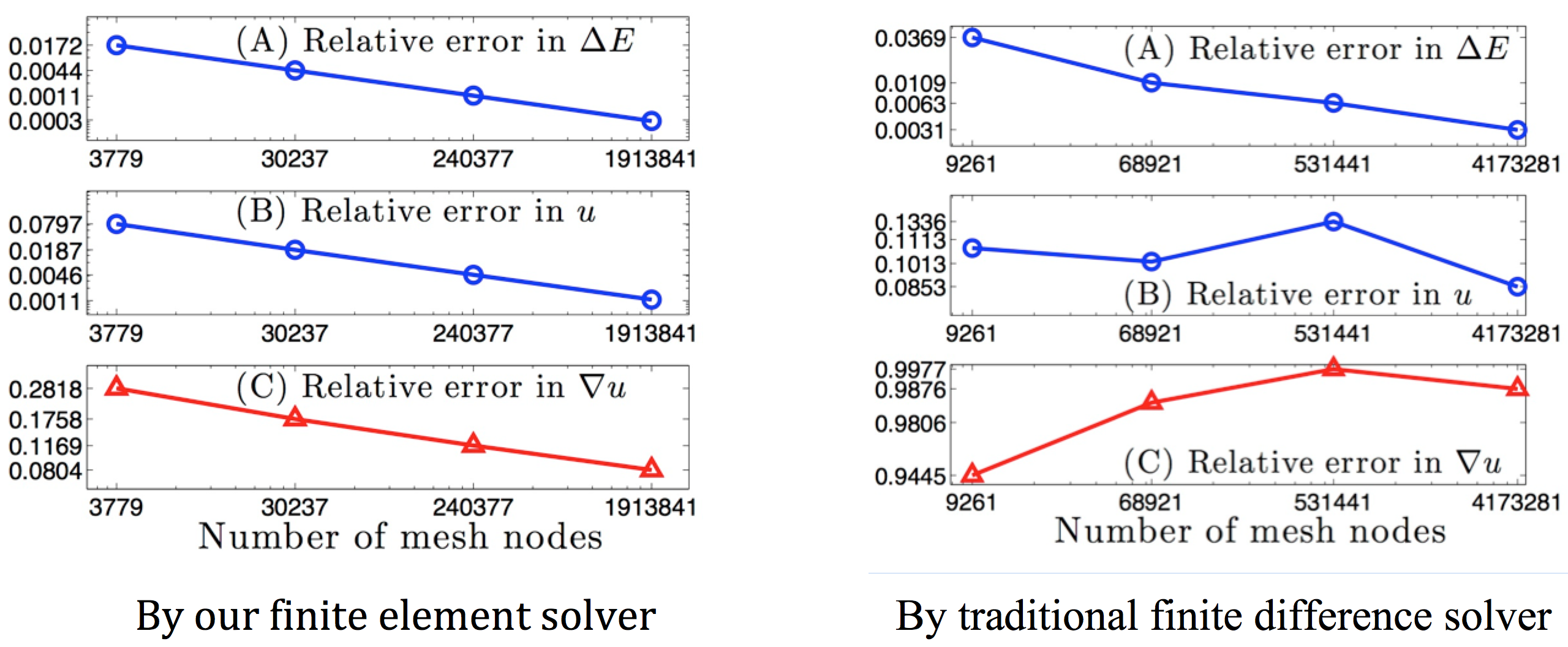Features of SDPBS
Main features of finite element solvers in SDPBS
Our finite element solvers in SDPBS have high accuracy in the numerical solution u of PBE, the calculation of solvation free energy ΔE, and the calculation of electrostatic field ∇u. To demonstrate this feature, we did numerical tests for solving a Poisson dielectric test model (a special case of PBE using Is = 0) as follows:

where Dp = {r| |r| < a}, and Ω = [-L,L]3 with L > a > 0. The analytical solution of the above Poisson model can be found in [4, Theorem 6.1]. Using this analytical solution, we can get the analytical value of the electrostatic solvation free energy and the analytical electrostatic field ∇u. Hence, we can calculate the relative errors of numerical solution uh, numerical solvation free energy ΔEh, and numerical electrostatic field ∇uh, respectively.

As comparision, we programmed the traditional finite difference method for solving the Poisson test model (1) according to the scheme proposed in [2, 3] as a system of second order central finite difference equations in the form:

where i,j,k = 0,1,2,...,N,h = 2L/N,

and the other discrete values of ε are defined similarly. Here ε(r) and f(r) are defined by

with δh(r - rj) being an approximation of δrj by the fractional charge weighted scheme [1].
In the tests, we set Ω = (-2,2)3, a = 1, L = 2, and np = 2124. The 2124 point charges were constructed by scaling the atomic charges of a protein with PDB ID 1TC3.
From the above two figures we can see that the finite difference solver had a much lower accuracy than our finite element solver in the calculation of numerical solutions. Even on a small mesh with only 3779 mesh points, our finite element solver produced more accurate numerical solutions than the finite difference method on a large mesh of 4173281 mesh points. This implies that our finite element solver can have better performance than the finite difference method in both CPU time and computer memory if the same numerical accuracy is required for the both solvers. We also see that the finite difference solver had a certain accuracy in the calculation of the electrostatic solvation free energy. Hence, the finite difference solver can be still valuable in the application problems that involve solvation free energies due to its simplicity and efficiency in implementation.
References
- I. Klapper, R. Hagstrom, R. Fine, K. Sharp, and B. Honig, Focusing of electric fields in the active site of cu-zn superoxide dismutase: Effects of ionic strength and amino-acid modification, Proteins: Structure, Function, and Bioinformatics 1 (1986), no. 1, 47-59.
- A. Nicholls and B. Honig, A rapid finite difference algorithm, utilizing successive overrelaxation to solve the Poisson-Boltzmann equation, J. Comp. Chem. 12 (1991), 435-445.
- W. Rocchia, E. Alexov, and B. Honig, Extending the applicability of the nonlinear Poisson- Boltzmann equation: Multiple dielectric constants and multivalent ions, J. Phys. Chem. B 105 (2001), 6507–6514.
- D. Xie and J. Ying, A new box iterative method for a class of nonlinear interface problems with application in solving Poisson-Boltzmann equation, Journal of Computational and Applied Mathematics, in press, 2016, doi:10.1016/j.cam.2016.01.005.
